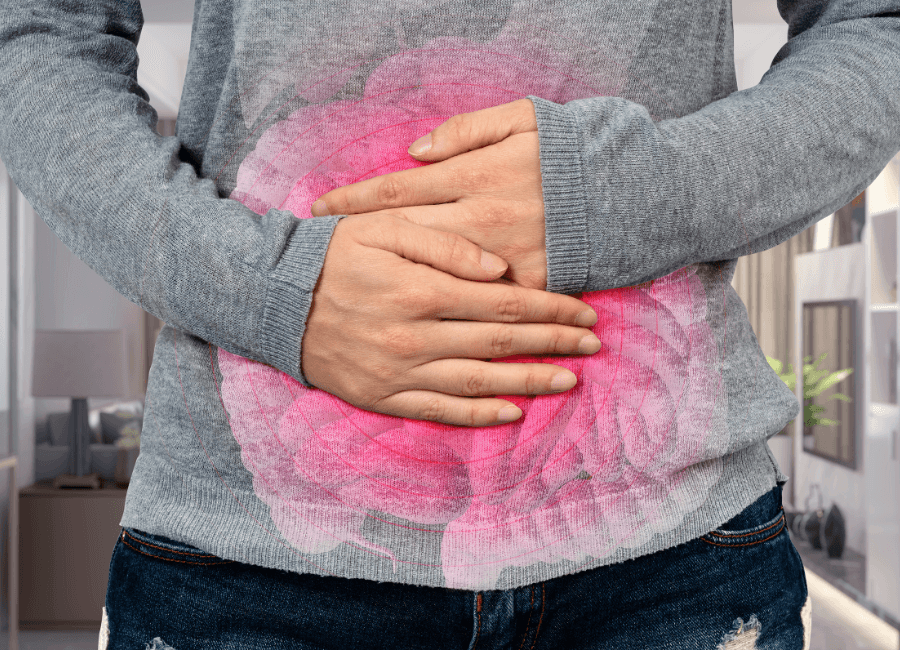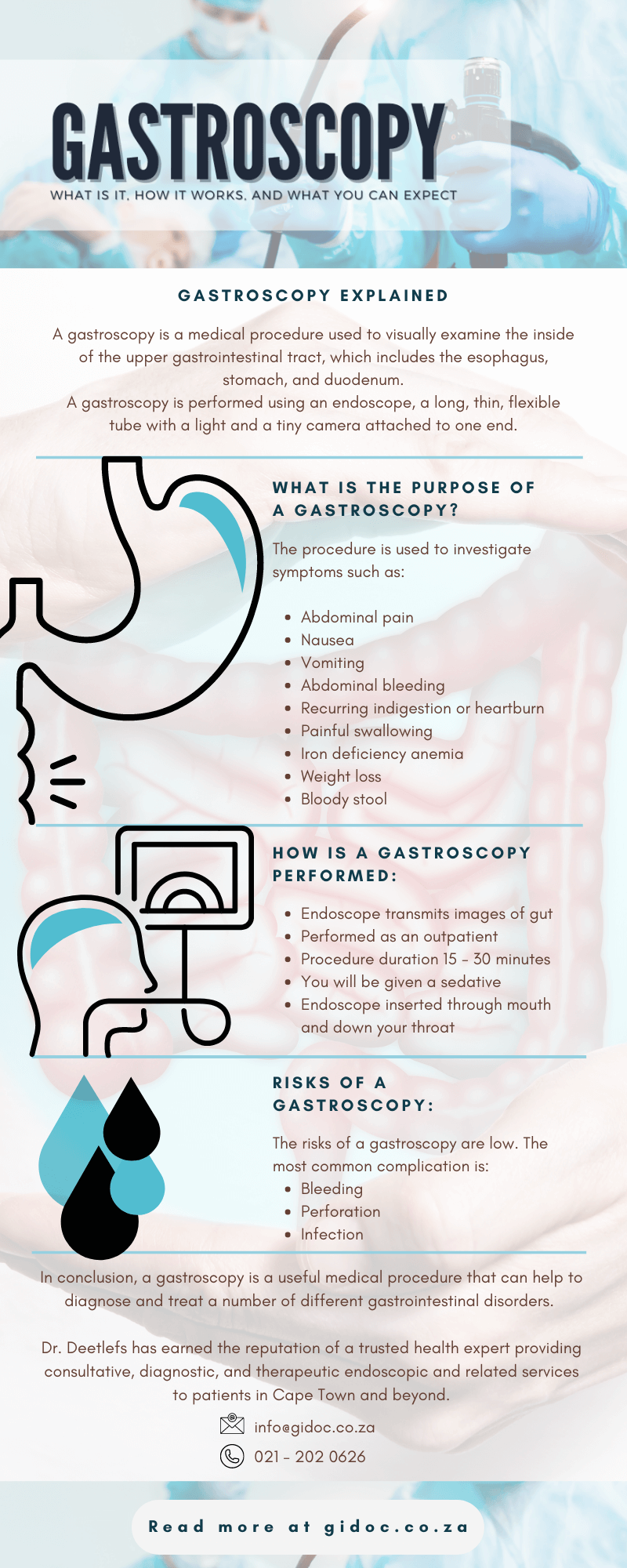Overview
A gastroscopy is a medical procedure used to visually examine the inside of the upper gastrointestinal tract, which includes the esophagus, stomach, and duodenum (the first section of the small intestine). It is also sometimes called an upper endoscopy or esophagogastroduodenoscopy (EGD). A gastroscopy is performed using an endoscope, a long, thin, flexible tube with a light and a tiny camera attached to one end. The endoscopes have built-in light sources and camera equipment that make viewing the inside of the gastrointestinal system easier to view. The camera allows the doctor to see the inside of the gastrointestinal tract on a monitor. The endoscope is inserted through the mouth and then passed down the esophagus, through the stomach, and into the duodenum. The camera transmits images of the inside of your digestive system to a video screen. This lets your doctor see any problems in your upper digestive system. Gastroscopy is used to diagnose and treat conditions of the upper gastrointestinal tract, such as ulcers, tumors, hiatal hernias and gastroesophageal reflux disease (GERD). The doctor may also take biopsies (tissue samples) during the procedure.Gastroscopy Explained
A gastroscopy allows your doctor to examine the inside of your upper digestive system. This includes your esophagus, stomach, and the first part of your small intestine (duodenum). Your doctor will use a thin, flexible camera called an endoscope to look inside your upper digestive system. An endoscope is a long, thin tube with a light and camera on one end. The endoscope is inserted through your mouth and down your throat. As the endoscope moves down your throat, your doctor will be able to see the inside of your upper digestive system on a monitor. When necessary, during the examination, a number of small procedures can also be carried out. These procedures may include:- Taking a small tissue sample (biopsy)
- Stopping bleeding from an ulcer
- Removal of polyps
What is the Purpose of a Gastroscopy?
This procedure is used to investigate symptoms such as:- Abdominal pain
- Nausea
- Vomiting
- Bleeding
- Abnormal bleeding
- Recurring indigestion or heartburn
- Painful swallowing
- Iron deficiency anaemia
- Weight loss
- Bloody stool
How is a Gastroscopy Performed?
The endoscope transmits images of the inside of the gut to a monitor, which the gastroenterologist will use to examine the gut for any abnormalities. A gastroscopy is usually performed as an outpatient procedure, meaning you can go home the same day. The procedure itself takes about 15-30 minutes. During a gastroscopy, you will be given a sedative to help you relax. Once you are sedated, the endoscope will be inserted through your mouth and down your throat. You will not be able to talk or swallow during the procedure.Preparing for a Gastroscopy
Your stomach should be empty during the procedure to make it possible to visualise the entire area and to decrease possibility of food or fluid being vomited into the lungs while under sedation (called aspiration). You should be fasting for solids from 8 pm on the day before the procedure. You may drink clear fluids (no milk) up to 3 hours before your gastroscopy on the day of the procedure. Before the test, a doctor will review the test, including possible complications, and will ask you to sign a consent form. The nurse or doctor will start an IV line in your hand or arm. Your blood pressure, heart rate and oxygen levels will be monitored during the test. The monitoring is not painful. For safety reasons, dentures should be removed before the procedure. The procedure typically takes between 10 and 20 minutes to complete. The endoscopy is performed while you lie on your left side. Sometimes the doctor will give a medication to numb the throat (either a gargle or a spray). A plastic mouth guard is placed between the teeth to prevent damage to the teeth and scope.What are the Risks of a Gastroscopy?
The risks of a gastroscopy are low. The most common complication is bleeding, which usually resolves on its own. Other risks include perforation (tearing) of the gastrointestinal tract, infection, and reactions to the sedative used to keep you comfortable during the procedure.What to Expect During and After Gastroscopy
The endoscope is inserted through the mouth and passed down the esophagus into the stomach. The gastroscopy procedure itself is generally painless, although you may experience some discomfort from the insertion of the endoscope. After your gastroscopy, your nurse or endoscopist will talk to you about how the test went. They will tell you if they took any biopsies and when to expect the results. You might have some bloating and discomfort after the procedure. This usually lasts for a few hours. If you haven’t had sedation, you can usually go home shortly after having the test. You will need to refrain from eating or drinking for approximately one hour after the local anesthetic spray has been applied. For 24 hours after having sedation, you shouldn’t:- drive
- drink alcohol
- operate heavy machinery
- sign any important documents
How is a Gastroscopy Used to Diagnose Chronic Inflammation?
One of the most common and well-known uses of a Gastroscopy is to find and treat chronic inflammation. Chronic inflammation of the gastrointestinal tract is a condition that can lead to a number of serious health problems, such as Crohn’s disease, ulcerative colitis, and celiac disease. Early diagnosis and treatment of chronic inflammation is essential to preventing these conditions from developing or progressing. A gastroscopy is often used to diagnose chronic inflammation because it is a very effective way to visualize the inside of the gastrointestinal tract.Contact Dr. Deetlefs
In conclusion, a gastroscopy is a useful medical procedure that can help to diagnose and treat a number of different gastrointestinal disorders. If you are experiencing any symptoms that may be suggestive of a gastrointestinal disorder, such as abdominal pain, heartburn, or nausea, then you should speak to your doctor about the possibility of having a gastroscopy. Your doctor will be able to put your mind at ease and help you through the process. Gastroscopy is a safe and effective way to diagnose and treat a variety of gastrointestinal disorders. It is important to get authorisation from your medical aid as this is an expensive procedure and unless you obtain pre-authorisation they might refuse to pay. For any additional information regarding a gastroscopy procedure, it’s best to find a trusted and experienced Gastroenterologist who can answer your questions clearly, recommend appropriate solutions, and perform tests with precision and expertise. Dr. Deetlefs has earned the reputation of a trusted health expert providing consultative, diagnostic, and therapeutic endoscopic and related services to patients in Cape Town and beyond. Dr. Deetlefs can be contacted to confirm the estimated breakdown should you be interested in having the procedure done.DISCLAIMER: PLEASE READ CAREFULLY
The information on this website is to provide general guidance. In no way does any of the information provided reflect definitive medical advice and self-diagnoses should not be made based on information obtained online. It is important to consult a Gastroenterologist or medical doctor regarding ANY and ALL symptoms or signs including, but not limited to: abdominal pain, haemorrhoids or anal / rectal bleeding as it may a sign of a serious illness or condition. A thorough consultation and examination should ALWAYS be performed for an accurate diagnosis and treatment plan. Be sure to call a physician or call our office today and schedule a consultation.
© Dr. Eduan Deetlefs, Registered Gastroenterologist, GI Doc Cape Town
Our website information is not intended or implied to be a substitute for professional medical advice, diagnosis or treatment. Please consult a doctor about your specific condition. Only a trained physician can determine an accurate diagnosis and proper treatment.





